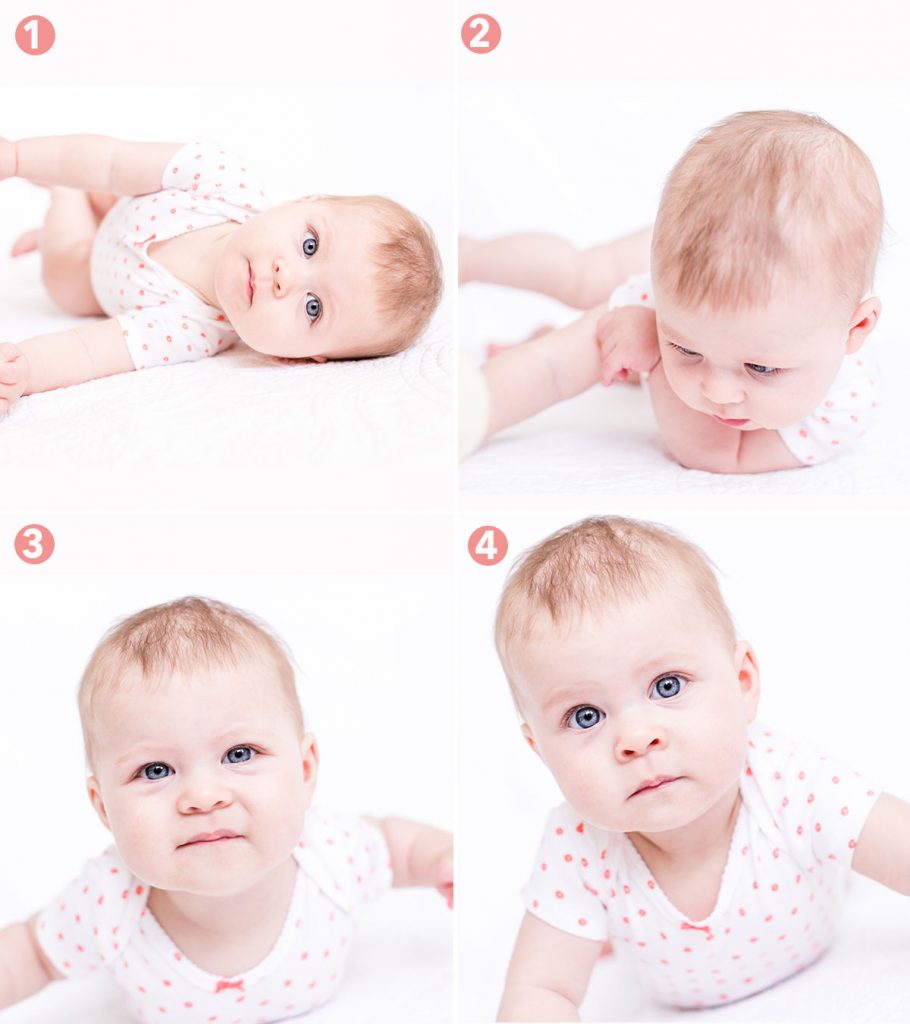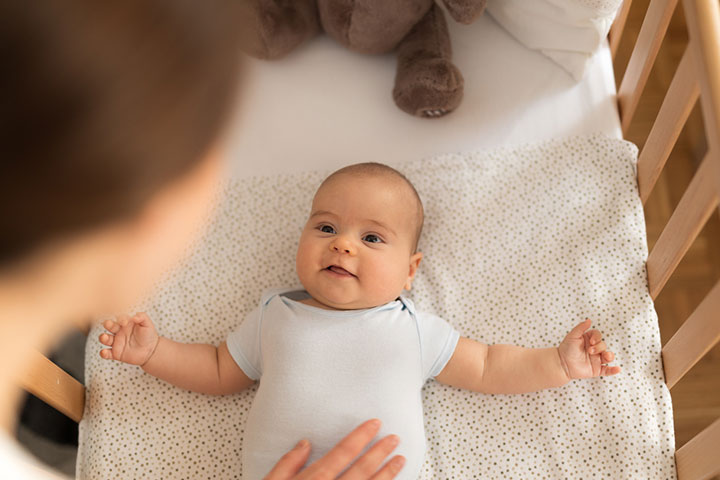Watching your baby go through different developmental phases is one of the most exciting and emotional parts of parenthood. These little milestones, such as when babies start to roll over, are the biggest achievements.
Rolling over requires a lot of muscle strength. There has to be good coordination in the upper body, and hence as your baby gets to this stage, it indicates their growth. There are different signs that indicate a baby might start to roll. Even though each baby is different and may master the skill at a different age, you can help them achieve it through simple exercises.
Besides, knowing the signs can help you take the necessary precautions for them to be safe while doing so. In this post, we tell you everything about rolling over in babies.
When Will Your Baby Roll Over?
When do babies roll over? The initial rolling over of babies typically occurs during tummy time. These are the times when the baby lies flat on the belly and uses arms to lift their head and shoulders off the floor. This move helps them strengthen the muscles in their head, neck, and upper body.
Once your baby attains the strength to lift its head, it will begin to roll over. Babies can overturn from lying on their back to lying on their tummy and vice versa (1). Babies start rolling over from belly to back and then pick up the back-to-belly action a month later. It is because the movements require more muscular strength and coordination.
Babies start their first rollover from belly to back around two to five months, back to side around four to five-and-a-half months, and from back to belly around five-and-a-half to seven-and-a-half months.
But by two to five months, babies attain enough strength in their upper body and use their arms to propel themselves from their belly to the back. By seven months, they not only master belly-to-back rolling over but also reverse back-to-belly movement. By seven months, they not only master belly-to-back rolling over but also reverse back-to-belly movement (2).
Jennifer, a mother of two from the UK, says that her baby, Olivia, showed a lot of growth in the fourth month. In her YouTube video, she says, “She has learned to laugh – not a giggle, but a proper, full laugh. And the day after she turned four months old, she learned to roll over from her belly onto her back. In the next week, she mastered the technique of going from her back on to her belly, too (i).
Simple Precautions You Need To Take
Babies usually roll over without any notice. So, it is important that you should never neglect your child while on the bed or any high surface. It may take a fraction of a second for them to roll over resulting in a fall. Therefore, make them lie on the floor when they show signs of rolling over.
How Will Your Baby Learn Rolling Over?
The physical development of a newborn starts with the head and then progresses to other body parts (2) (3).
At 1 Month:
- Can raise head for a moment.
- Turns head towards the side while on the back.
At 2 Months:
- Can hold head up and begin to push up when lying on tummy.
- Makes smoother movements with arms and legs.
- The head can bob forward while sitting.
At 3 Months:
- Can bear little weight while standing on both legs.
- Can control the head up while sitting, however, bobs forward.
- Can raise head and shoulders for 45 to 90 degrees while lying on the belly.
- Can carry weight on forearms.
At 4 Months:
- Good head control.
- Can carry up to a certain weight when held upright on legs.
- Can raise head and chest up to 90 degrees.
- Rolls over from back to the side.
At 5 Months:
- Can hold the head up while sitting.
- Rolls over from belly to back.
At 6 Months:
- Can raise the chest and a part of the belly while lying on the stomach.
- Can lift head while in a sitting position.
- Rolls over from back to belly.
How To Teach Your Baby To Roll Over?
If you’re wondering how to help a baby roll over, here are some steps that may assist you in teaching your little one to move independently for the first time. When you notice that your baby is getting comfortable on the floor and showing signs of eagerness to become mobile, you can follow these steps to guide them:
Step 1:
Place your baby on the floor while they are near tummy time. It makes your child comfortable as they use their neck muscles to keep their head upright.
Step 2:
Place them on the blanket with their left side lying on the blanket’s left edge. Let them become comfortable in this position and make sure they will keep their head up for at least a few seconds. If they fail to do so, it signals that they are still not ready to roll.
Step 3:
Keep a toy just a little distance away from the baby’s reach. Try to shake and play with it before placing it on the floor. Now watch whether your baby tries to get it. They may keep their arms out, and the new position will cause discomfort for sure.
Step 4:
As your baby tries to reach the toy, lift the blanket’s edge so that their right side is lifted in the air. Do not lift them over an inch. If they are upset with the position, try to lower and comfort them. Make sure this becomes a pleasant experience.
Step 5:
Keep one hand on their tummy and try lifting the edge of the blanket. Steady their position with your hand and cradle their body. Lift them until they can roll over their back. Ensure that they can reach the toy where they can perceive that rolling over made their move. Repeat the blanket activity every day until they become comfortable rolling over on their own.
Some babies do not enjoy their tummy time. If they make a fuss or cry, wait until they calm down before helping them roll over (4).
Tips That Help Your Baby Learn To Roll Over
You should keep a track of the changes that will happen at each stage before making your little one do those activities. Here are a few tips for your baby’s rollover (1) (2) (5) (6):
- Give your newborn tummy time from the initial day as it helps in developing muscles essential to rollover. It also lets your baby move her arms and legs and can boost her neck strength.
- Your baby may not like to be on the tummy initially as it can be a strange position. When the baby is in the second month, you can try placing it on its tummy for a minute or so. You can give tummy time when you put your baby on your chest as it can be a great alternative until getting adjusted.
- You can also get on the floor along with them and jiggle some favorite toys. At three months, when you place your baby on his tummy, he will lift their head and shoulders with arms. help. This discovery will give them the strength to roll on. It will amaze you as they flip from back to front and vice versa.
- At three months, when you place your baby on their tummy, they will lift their head and shoulders with the help of their arms. This small push up will give their the strength to roll on. It will amaze you as they flips from back to front and vice versa.
- You should encourage your little one to do push-ups by holding a toy above their head level. It will automatically tempt them to raise their head by straightening their arms.
- At around five to seven months, your little one can lift their head, push up their arms, and arch backward to lift their chest off the floor.
- You should encourage them to do all these acts as they strengthen their muscles, and they will learn to roll over in both directions.
- When you are placing your baby down, roll them to one side and encourage them to get back by themselves. Try the same when lifting your baby.
- Give them a toy, mirror, or any safe object while they are lying on a side. If they are not able to remain in that position, give them some support.
- Make your little one twist both their upper and lower body by twisting their legs and arms.
- Keep your little one in carriers so that they remain in a frog-like positioniXWhen the legs of the baby have spread apart and bent in a frog-like fashion, stretching the hips and inner thighs. rather than a straddling positioniXWhen a baby leans against someone, the thighs are supported, the hips and knees are bent, and the hips fall or spread to the side..
- Carry them in a tucked-in position if you take them for a walk. You can also dance with your baby close in your arms.
- Do not allow your baby to stay long on any baby equipment. It may include swings, play saucers or bouncer chairs. These will prevent their from practicing motor skillsiXThe ability to control and coordinate body movements such as walking, running, and moving hands and fingers.. Let their stay in open and indulge in different movements.
- Have enough tummy time every day since all the major motor skills arise from that position. It is good for babies to lie on their tummy to strengthen their neck and shoulder muscles for creating an arch against gravity.
- Give your baby some time to rest on their back in a folded position. It provides a balance between extension that is arching and flexion that is in a tucked positioniXA close-knit position in which the body is folded in or curled up, with the knees near the chest.. Lying on the back can happen while your baby is on your lap. It is important as it allows the baby to flex their knees, trunk, and hip muscles.
- Do not allow your baby to remain in the same position for long. Try to change the position every 15 minutes. It exposes them to all positions that involve rolling.
- Encourage your baby to play in midline position for movement around the invisible line present in the center of the body. The ability to roll depends on your little one’s ability to cross that midline (7).
How To Encourage Your Baby To Roll Over?
You can play with your little one to encourage them to roll over.
- Jiggle their favorite toy so that they try to move towards it.
- Use a toy that your baby likes the most.
- Lie close to them to roll on to get to you.
- If they reach for the toy or to you, cheer them up by making them smile. She may then get more enthusiastic to flip their body.
- Encourage them to roll on both sides. It helps develop their balancing muscles.
Baby Rolling Over And Safe Sleeping
You need not worry if your baby is rolling over while sleeping. It means they are strong to hold their head and can roll onto their back. They usually start rolling on their tummy, followed by back, and eventually in all four positions.
During the first year, you should make them lie only on their back so as to avoid sudden infant death syndromeiX An infant below one year of age dies suddenly and without apparent cause. (SIDS). When you notice your baby rolling over during sleep, try to place them on their back (2). The SIDS risk for your baby decreases after four months. Once your baby completes one year, there is almost zero risk (8).
What Can You Do If Your Baby Rolls Over During Sleep?
1. Baby Just Started Rolling:
When your baby rolls, keep their back to the usual sleeping position. If they are upset, wait for about 15 minutes. If they are still worried, give them a chance to learn about the new position and roll them back after a while.
2. Baby Rolling For A While:
If you notice them roll over, try rolling them back to the usual sleeping position. If you see them upset, soothe them until they fall asleep. If they roll over before midnight, let them sleep in the new position or roll back into the usual position.
3. Rolling During Daytime:
During the daytime, allow your baby to roll. Place them on their belly and leave for up to 15 minutes. It helps to strengthen their back. You can try rolling them from back to belly and again back. Repeat it during bedtime. It will help them remember to roll back to the usual sleeping position if they are irritated with the new position.
Tips for Safe Sleep Practices In Baby
Here are some tips (9) (10):
- Until six months of age, make sure your baby sleeps on her back on a bed. It is the safest position to put her to sleep.
- Keep your baby’s bed clean without any extra pillows, blankets, or stuffed toys as they may cause suffocation.
- Do not sleep along with your baby if you have taken drugs or alcohol.
- Do not cover your baby’s head; just tuck her with a blanket past her shoulders.
- Maintain the room’s temperature at 20 to 22 degrees C (11).
What To Expect Next After Your Baby Rolls Over?
The muscles that are involved in your baby’s rolling over are the same that help your baby crawl and sit (1).
- Once your baby rolls over perfectly, her neck, legs, arms, and back become stronger, and she will start sitting, first with your support, and later unassisted.
- She will then crawl, followed by standing and then walking on both feet.
Your Baby Is 7 Months Old And Still Cannot Roll. Is It A Concern?
Every baby is different from the other. Some develop skills quickly while some may take time. It is the same with rolling over (12).
- Your baby might skip rolling over and progress to sitting and crawling. As long as she continues gaining new skills and gets around, she is making progress.
- But if your baby is not rolling over and has also not moved to other skills like sitting or crawling, you should check with her doctor.
- Also, if your baby is a preterm baby, the milestones and achievements may be delayed.
When babies start to roll over, it is the first stage in their development of postural control. Once your baby is about two to five months old, their first rolling over occurs during tummy time. This developmental milestone is essential since it assists babies in strengthening the head muscles, neck, and upper body. Different newborns, however, may master this ability at different ages. You may also help your baby turn over by giving them tummy time and using a toy, but ensure your baby’s safety first.
Personal Experience: Sources
i. 4 Month Baby Update | Rolling Over, Sitting Up, Touching Toes and Really Laughing.
https://www.youtube.com/watch?v=h9jSxTM8zh8
Key Pointers
- Rolling over is a developmental milestone that shows improved muscle coordination and strength.
- Babies start rolling over from belly to back at 2-5 months and back to tummy at 5-7 months.
- Parents must take precautions and never leave their child alone on high surfaces.
- Help your baby strengthen their muscles by doing push-ups and twisting movements.
- Provide your baby with sufficient rest and various postures to practice new actions.
Celebrate your baby’s exciting step towards independence as they master the art of rolling. Delight in their joyful exploration of newfound mobility, a testament to their evolving abilities.














